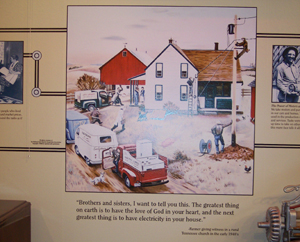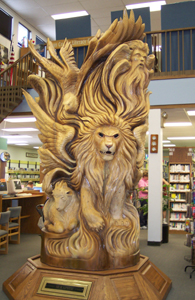We will remember Rawlins, Wyoming for two things: high winds and the Wyoming scones.
 Scones at Hungry Miner Cafe
Unlike scones elsewhere, these are rounds of buttermilk bread dough, fried and dusted
with cinnamon sugar, and served for breakfast at the Hungry Miner Cafe. Delicious!
(Better, we have to say, than the fried dough in Olancha, California.) Two scones
make a complete breakfast, or better yet, three make a good breakfast for two.
Scones at Hungry Miner Cafe
Unlike scones elsewhere, these are rounds of buttermilk bread dough, fried and dusted
with cinnamon sugar, and served for breakfast at the Hungry Miner Cafe. Delicious!
(Better, we have to say, than the fried dough in Olancha, California.) Two scones
make a complete breakfast, or better yet, three make a good breakfast for two.
We headed south from Laramie, passing through mountain valleys surrounded by
 Curious antelope
forested slopes with patches of snow, past herds of antelope and then down the long
eastern slope of the Rockies to Fort Collins. Every bit of the road was scenic.
It's amazing what a few trees will do to improve the appearance of a bald grasssy hill.
Curious antelope
forested slopes with patches of snow, past herds of antelope and then down the long
eastern slope of the Rockies to Fort Collins. Every bit of the road was scenic.
It's amazing what a few trees will do to improve the appearance of a bald grasssy hill.
Colorado Highway 14 is probably best known for winding through the Rocky
 Sheep in feed lot
Mountains west of Fort Collins, but we took this road east. With the aid of the
snow melt from the Rockies the irrigated land grows sugar beets, onions, carrots,
along with a huge feedlot of sheep (unfortunately, not Katahdins). When we discovered
the highway was given a distinguishing blue sign and named the Pawnee Pioneer Trail,
we followed this Trail along dirt roads through the Pawnee National Grassland.
Sheep in feed lot
Mountains west of Fort Collins, but we took this road east. With the aid of the
snow melt from the Rockies the irrigated land grows sugar beets, onions, carrots,
along with a huge feedlot of sheep (unfortunately, not Katahdins). When we discovered
the highway was given a distinguishing blue sign and named the Pawnee Pioneer Trail,
we followed this Trail along dirt roads through the Pawnee National Grassland.
The Grassland came into being because this had been dust bowl country in the
 Pawnee Buttes, Colorado
thirties, and about half of the land has been returned to short-grass prairie spotted
with short clumps of opuntia cactus. We kept seeing signs for Pawnee Buttes, and
scoured the horizon, but didn't see any. Then we drove up a mesa and lo! there were
two gigantic buttes, just as advertised. We declined the three-mile round trip hike
to the observation point, because you could see the buttes just fine, and besides, it
was a raptor nesting area and we thought we'd give the eagles and hawks some room.
You won't find Pawnee Buttes on an AAA map although the tour book had a brief
description of this Byway. Another thing you won't find on the maps is the cluster
of missile silos along the trail.
Pawnee Buttes, Colorado
thirties, and about half of the land has been returned to short-grass prairie spotted
with short clumps of opuntia cactus. We kept seeing signs for Pawnee Buttes, and
scoured the horizon, but didn't see any. Then we drove up a mesa and lo! there were
two gigantic buttes, just as advertised. We declined the three-mile round trip hike
to the observation point, because you could see the buttes just fine, and besides, it
was a raptor nesting area and we thought we'd give the eagles and hawks some room.
You won't find Pawnee Buttes on an AAA map although the tour book had a brief
description of this Byway. Another thing you won't find on the maps is the cluster
of missile silos along the trail.
We had picked Sterling because our latest tour book, Off the Beaten Path
 Overland Trail Museum display
(published by Readers' Digest) mentioned the Overland Trail Museum. We had really
liked the Sweetwater County Museum in Green River, and the Overland Trail Museum
was much better. It's one of those historical museums with a little bit of everything -
clothing, arrowheads, fossils, dolls, guns, tractors, windmills, musical instruments,
china, racks of old newspapers, doctor's offices, barber shops, saddles, old tools,
badges -- the list goes on and on. Started in 1936, the museum had begun by collecting
the old junk from pioneer families, and has now expanded to include an annex and
outbuildings depicting shops and stores and a church from the nineteenth and early
twentieth century. It's a favorite day trip for schoolchildren.
Overland Trail Museum display
(published by Readers' Digest) mentioned the Overland Trail Museum. We had really
liked the Sweetwater County Museum in Green River, and the Overland Trail Museum
was much better. It's one of those historical museums with a little bit of everything -
clothing, arrowheads, fossils, dolls, guns, tractors, windmills, musical instruments,
china, racks of old newspapers, doctor's offices, barber shops, saddles, old tools,
badges -- the list goes on and on. Started in 1936, the museum had begun by collecting
the old junk from pioneer families, and has now expanded to include an annex and
outbuildings depicting shops and stores and a church from the nineteenth and early
twentieth century. It's a favorite day trip for schoolchildren.
Sterling is the birthplace of David Hamil, who went into politics, became
 Rural Electrification cartoon
speaker of the Colorado legislature and a candidate for governor, and was appointed by
President Eisenhower to be head of the Rural Electricification Agency, a position
which he held for twenty years. When he retired, he showed his head was not turned
by the glamour and power of Washington, and returned to his home town of Sterling
where he engaged in voluntary public service. Hamil died in 2002 and his wall of
testimonials is on display in the museum.
Rural Electrification cartoon
speaker of the Colorado legislature and a candidate for governor, and was appointed by
President Eisenhower to be head of the Rural Electricification Agency, a position
which he held for twenty years. When he retired, he showed his head was not turned
by the glamour and power of Washington, and returned to his home town of Sterling
where he engaged in voluntary public service. Hamil died in 2002 and his wall of
testimonials is on display in the museum.
We wondered what the secret was -- how could a town of 11,000 people
(albeit the "fastest growing city in Northeastern Colorado") have such a wonderful
museum? Apparently it started out as a project of the Historical Society and now
 Charles Russell illustration
is a town-financed project. But there's more to the story than that -- the entire
community of Logan County in Northeastern Colorado supports the museum, and even
when the kids know this or that would fetch a pretty penny on Ebay, the parents
leave it to the museum for the whole community to enjoy. The city of Sterling has
a great website, and the museum is featured at http://www.sterlingcolo.com/parks/pr_mus.htm.
Charles Russell illustration
is a town-financed project. But there's more to the story than that -- the entire
community of Logan County in Northeastern Colorado supports the museum, and even
when the kids know this or that would fetch a pretty penny on Ebay, the parents
leave it to the museum for the whole community to enjoy. The city of Sterling has
a great website, and the museum is featured at http://www.sterlingcolo.com/parks/pr_mus.htm.
Inside the museum is a print of a postcard drawn by Charles M. Russell,
depicting a skeletal cow confronting coyotes. The explanation says: 'The picture
that made Russell famous. In 1886 he was an unknown cowboy helping tend a great
herd of cattle owned by Stadler and Kaufman in Montana. A series of blizzards that
 Seraphim,
Seraphim,
by Bradford Rhea
winter caused the "Big Die-up" on the Northern Plains when thousands of sheep and
cattle were lost. His employers wrote from their warm city hotel to inquire about
the condition of their cattle. In answer Russell sketched this picture on a post
card and sent it to them. It was immediately copied by newspapers all over the
country. The terrible snow storms of the middle 1880's spelled the end of the
great cattle barons and helped to open the west to the homesteaders." (Those storms
also ended the ambitious career of Elsa's great-uncle Jack Cadwell in Ellsworth,
Kansas, not too far from Sterling).
Another famous artist, Bradford Rhea, lives in Sterling today. We almost
didn't go to see his work, because we (mistakenly) thought they were chain-saw
sculptures. You see, Sterling had a lot of elms which were dying off from Dutch
Elm disease, and we were reminded of Truro, NS, which had indeed transformed the
trees into chain-saw sculptures. Truro's trees were pleasant and humorous, but
 Skygrazer, by Bradford Rhea
Rhea's trees are breathtakingly beautiful, romantic and inspirational, and range
from angels and wild animals to butterflies and the Minuteman, in front of the
National Guard Armory. As the wood decays, Rhea is transforming his sculptures
to bronzes, which is giving Sterling some civic art of which large cities might
be jealous. Rhea, it turns out, spent three months in Florence, where he was
inspired by the work of Michelangelo. He has lately been working in white marble,
and was selected by President Clinton to carve a staff to be given as a present to
Pope John Paul II. Bradford Rhea's website is www.thesculptor.net
Skygrazer, by Bradford Rhea
Rhea's trees are breathtakingly beautiful, romantic and inspirational, and range
from angels and wild animals to butterflies and the Minuteman, in front of the
National Guard Armory. As the wood decays, Rhea is transforming his sculptures
to bronzes, which is giving Sterling some civic art of which large cities might
be jealous. Rhea, it turns out, spent three months in Florence, where he was
inspired by the work of Michelangelo. He has lately been working in white marble,
and was selected by President Clinton to carve a staff to be given as a present to
Pope John Paul II. Bradford Rhea's website is www.thesculptor.net
Here is his poem to accompany Skygrazer (the giraffes): Just beyond the
clouds of doubt and chaos they appeared -- a congregation of spingling appendages
fused in a mass of true belief, with heads reaching all directions in a quest for
the elusive, intangible faith. Only a glimpse of the creature was visible as it
hovered for a millisecond in space and time before galloping with long legged
strides toward the heavens.
What gives a city like Sterling its energy and creativity, while other
towns seem dreary and empty? It's the people.
 Scones at Hungry Miner Cafe
Unlike scones elsewhere, these are rounds of buttermilk bread dough, fried and dusted
with cinnamon sugar, and served for breakfast at the Hungry Miner Cafe. Delicious!
(Better, we have to say, than the fried dough in Olancha, California.) Two scones
make a complete breakfast, or better yet, three make a good breakfast for two.
Scones at Hungry Miner Cafe
Unlike scones elsewhere, these are rounds of buttermilk bread dough, fried and dusted
with cinnamon sugar, and served for breakfast at the Hungry Miner Cafe. Delicious!
(Better, we have to say, than the fried dough in Olancha, California.) Two scones
make a complete breakfast, or better yet, three make a good breakfast for two.
 Curious antelope
Curious antelope Sheep in feed lot
Sheep in feed lot Pawnee Buttes, Colorado
Pawnee Buttes, Colorado Overland Trail Museum display
Overland Trail Museum display Rural Electrification cartoon
Rural Electrification cartoon Charles Russell illustration
Charles Russell illustration Seraphim,
Seraphim, Skygrazer, by Bradford Rhea
Skygrazer, by Bradford Rhea